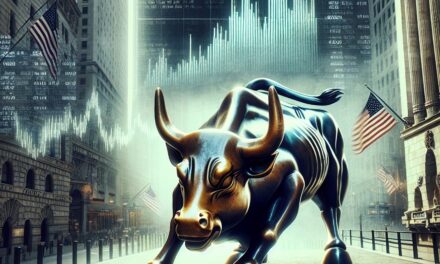On December 31, 2025, the sun will officially set in Omaha.
That’s right folks …
Warren Buffett has announced he will step down as CEO of Berkshire Hathaway Inc. (BRK.B) at the end of the year, though he’ll remain on its board of directors.
How exactly did Buffett become an investing legend and earn himself the nickname, “Oracle of Omaha?” Quite simply, he grew his company into a $1.1 trillion conglomerate while delivering an astonishing 5,500,000% return to investors.
Suffice it to say, Buffett is in a league of his own.
But that doesn’t mean we can’t learn something from his approach, with the aim of making ourselves better investors.
And even though Buffett was largely a “discretionary” manager, there are systematic tools you can use today to get yourself very close to the essence of his strategy.
Let me show you what I mean …
The Oracle’s Investment Strategy
Buffett’s strategy is often boiled down to what we call “value investing.”
But at the heart of it is also a commitment to buying only the highest-quality companies, and then holding them for a very long time.
I mentioned how Buffett is a “discretionary” manager, rather than a systematic investor, or “quant.”
In his decision-making process, Buffett reads all of a company’s annual reports, dating back as far as he can get his hands on.
He examines a company’s business strategy and evaluates its progression of execution.
Buffett is thorough and deliberate in his actions… he doesn’t buy up every company he looks at, but only the ones with the strongest fundamentals … and only if he can buy them at a favorable price.
While many have argued that Buffett’s magic touch cannot be replicated, others have tried their best to codify the filtering criteria he uses to either buy or pass on a stock.
In fact, the software suite I use to operate my Green Zone Power Rating system includes a handful of pre-built screens, including a “Buffett” system …
The screen aims to identify only the best-of-the-best “Buffett” stocks, using a handful of quality criteria.
It determines if a company uses debt safely by looking at two debt ratios …
First, if the company has been sufficiently profitable over the last four quarters, and over the last five years …
And second, if the company’s revenue and earnings is growing sustainably, over both the past year and five years … and whether the rate of growth is greater than its industry peers.
All told, it’s a great screen for identifying quality companies that can be trusted to continue growing for years to come!
And the results speak for themselves: Since 1999, this simple “Buffett” screen produced a return of 1,857% versus the S&P 500’s return of just 622% over the same time.
Think about that, folks …
Maybe you feel like you can’t do what Buffett has done during his decades-long career … but you can beat the market’s return by several multiples, just by following a simple rules-based system.
That should be empowering, if you ask me!
Of course, that’s also what my Green Zone Power Rating system is designed to do.
So as my good friend and lead analyst, Matt Clark and I were examining the results of the Buffett screen I described above, we got to thinking …
Could My Green Zone System Improve the “Buffett” Screen?
As you likely already know, my Green Zone Power Ratings system rates the quality of a company using 32 individual metrics, including asset turnover, free cash flow, margins, returns on assets, investment, equity, and earnings per share.
But “Quality” is only one of the six broader factors it uses to rate companies and their stocks. The other five are: momentum, size, volatility, value and growth.
The questions Matt Clark and I sought to answer were:
- Can we “validate” the efficacy of our own Green Zone Power Rating system, by comparing the results of our system and Buffett’s screening criteria?
- Can we add performance “alpha” to that Buffett screen, by additionally using my Green Zone system to whittle down the list of stocks we want to buy?
To get at an answer to the first question …
We first determined how many stocks meet the criteria for the “Buffett” screen currently. That came out to just 61 stocks out of a universe of more than 3,000.
Next, we determined how many of those stocks also rate “bullish” or better on my Green Zone Power Rating system, currently. We learned that 41 of the 61 “Buffett” stocks, or 67%, are currently rated bullish.
Lastly, we determined if that proportion (67%) was high or low, relative to the proportion of bullish stocks in the entire universe. We confirmed that only between 35% and 40% of all stocks earn a bullish or better rating at any given time …
All of which means, my system does an excellent job of validating the superior stocks that the “Buffett” screen has identified as best-of-the-best stocks.
Next, we sought to answer our second question by adding one simple rule to the Buffett screen. That is … the stock must be rated 60 or higher (aka, “bullish” or better).
Remember, Buffett’s screen alone transformed the market’s 622% return since 1999 into a 3X-greater return of 1,857%.
Well, adding that one additional “Green Zone bullish” rule improved the returns even more … generating a total return of 3,138% over the same time frame!
Lastly for this exercise, I asked Matt to screen for an even more stringent list of stocks, those that:
- Passed “Buffett’s” screen, and
- Are rated “bullish” or better overall, on my Green Zone Power Rating system, and
- Are rated “bullish” or better on each of the six individual factors.
Here are those results, currently:

Impressively, Matt and I whittled the list 61 “Buffett” stocks down to just four — two rating a perfect 100 overall, and two rating 99.
It’s no surprise that all four stocks rate highly on Quality, the focus of the Buffett screen. But even better … these stocks rate “bullish” across the board, making them truly well-rounded stocks that can easily be called “cream of the crop.”
Pro tip: Matt and I recently recommended one of these four stocks to subscribers of my Green Zone Fortunes PRO service.
Click here to find out more about this service, which stock we recommended and whether it is still a buy.
Otherwise, we hope you found today’s exercise valuable …
By using my Green Zone Power Ratings system, we not only found stocks that fit the Oracle of Omaha’s criteria, but we drilled down to find the absolute best of the best on that list.
And in turn, I hope we proved that, while you may not have the magic touch Uncle Warren has, you can get pretty close to replicating his market-trouncing returns … if you use the right tools.
To good profits,

Editor, What My System Says Today




